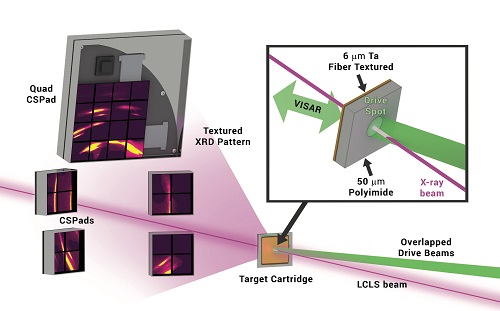Research with X-ray Free Electron Lasers
X-ray free electron lasers (XFELs) are one of the most exciting developments in modern experimental physics (indeed, they were the topic of a 2015 Nobel symposium). Often referred to as 4th generation light sources they represent a step change in capability from the more ubiquitous synchrotron. Both operate on the principle of accelerating electron bunches and generating X-rays by introducing transverse oscillations in the electron trajectory. In XFELs the generated X-rays pulses become intense enough to structure the electron bunches, and in doing so, lead to brighter, more coherent X-ray generation (as in a conventional laser).
Imaging of ablatively driven shock waves in diamond. Reproduced from Schropp et al. (2015).
One area of particular interest in York is in using the bright X-rays from XFELs to probe laser compressed matter. When an intense optical laser is focused onto a solid target the surface is rapidly heated, producing a plasma. This ionised gas expands from the sample surface, and via reaction, applies a compressive force to the solid sample behind. This ‘ablative drive’ mechanism can is routinely used to produce solid material at many millions of times atmospheric pressure; conditions comparable to that of a planetary core. As shown above, the compressive shock waves generated can be directly imaged using the highly coherent XFEL X-rays.
An X-ray diffraction experiment carried out at the LCLS. Reproduced from C. Wehrenberg et al. (2017).
By utilising the XFEL beam as a probe, X-ray diffraction measurements can be taken which elucidate not only the crystallographic structure of this material, but help us to understand the deformation mechanisms which mediate the rapid material response (see Milathianaki et al, Wehrenberg et al). These X-ray diffraction techniques allow a rare glimpse into the behaviour of materials under extreme conditions, whether that is astrophysical, or more ‘everyday’ applications such as understanding materials processing, or behaviour of materials in modern jet engines.
As apply successively stronger ablative drives we move the material from solid, through liquid, and then into a state known as warm dense matter (WDM). WDM can be characterised as material too warm and ionised to be well described by solid state physics, but too correlated and ‘quantum’ to fit with the classical models of plasma physics. This theoretical no man’s land can be well explored via X-ray techniques, and as such is likely to become a major focus of XFEL work in the near future. Indeed the XFEL radiation itself is sufficiently intense to isochorically heat matter into this regime (see Vinko et al.)
2017 saw first experiments start at the European XFEL in Hamburg, Germany. In 2018 its High Energy Density instrument will see the combination of cutting edge optical lasers with the world’s first superconducting XFEL. The unique combination of optical and X-ray capabilities will open up new classes of experiment to explore matter in extremes. The University of York is working with its colleagues in Germany to prepare for this exciting new stage in XFEL science.
References
A Schropp et al. “Imaging Shock Waves in Diamond with Both High Temporal and Spatial Resolution at an XFEL”, Scientific Reports, 5, 11089 (2015)
C. Wehrenberg et al. “In situ X-ray diffraction measurement of shock-wave-driven twinning and lattice dynamics” Nature 550, 496–499 (2017)

